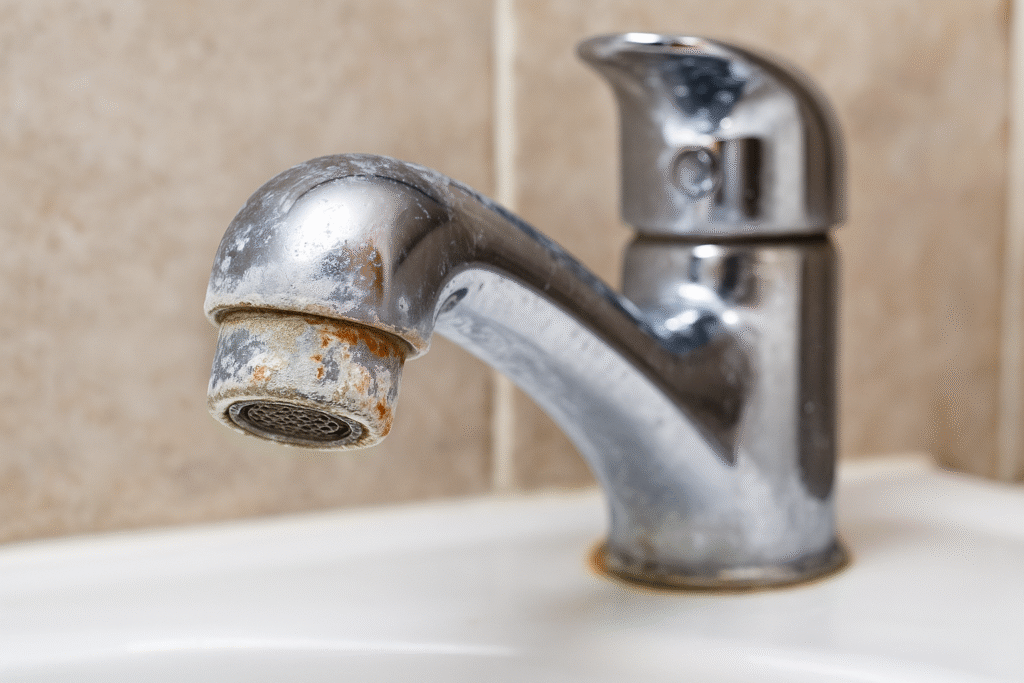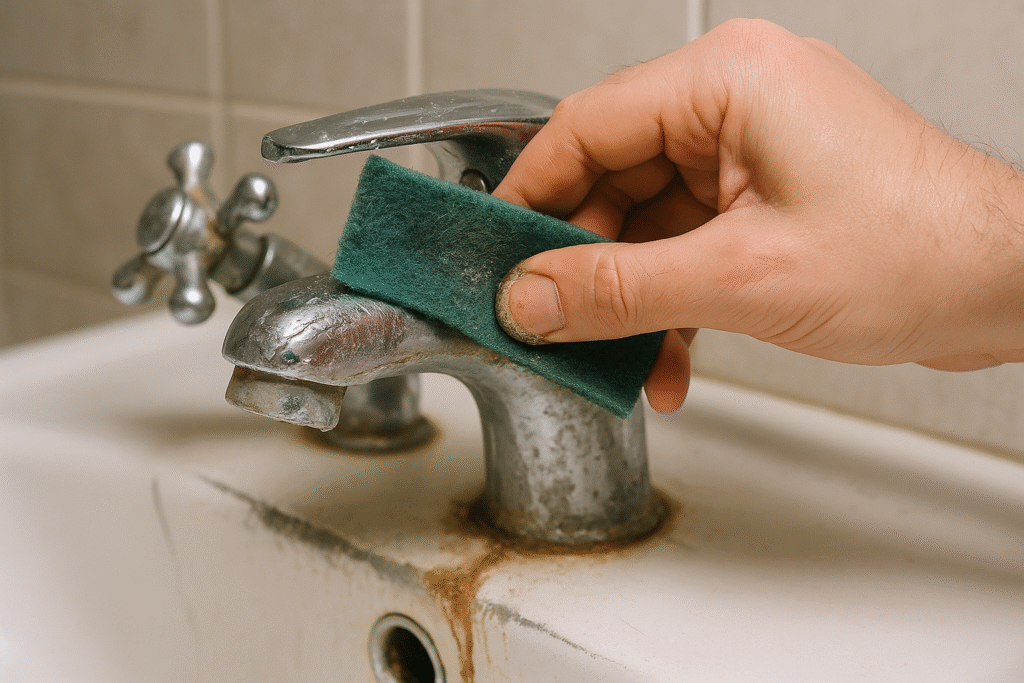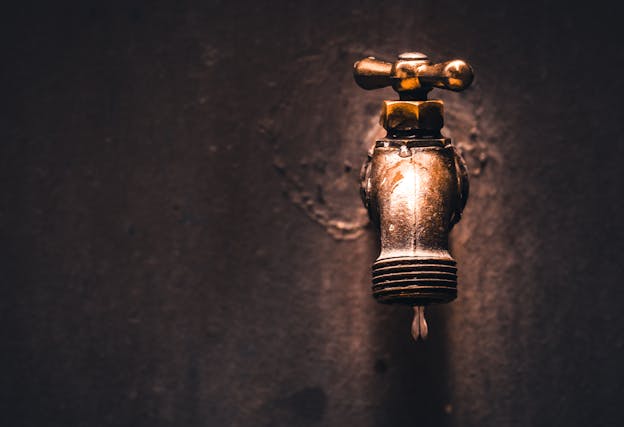Introduction
Hard water deposits are a common household problem, and if you’ve noticed stubborn white stains, chalky buildup, or reddish-brown marks on your sinks, showers, or faucets, you’re likely dealing with calcium lime rust. This issue occurs when minerals like calcium and magnesium in hard water accumulate on surfaces, often leaving behind unsightly scale. Over time, the buildup combines with iron particles to create rust, making fixtures look dirty, old, and poorly maintained. These deposits don’t just affect appearances—they can also interfere with water flow and damage the materials they cling to.
Knowing how to treat calcium lime rust is important because it can impact both functionality and hygiene. In bathrooms and kitchens, mineral buildup makes cleaning harder, while rust can leave surfaces feeling rough and corroded. Beyond aesthetics, these deposits can shorten the lifespan of faucets, showerheads, and even appliances like dishwashers or coffee makers. Addressing the problem quickly prevents small issues from becoming expensive replacements. Fortunately, with the right approach, calcium lime rust can be removed safely and effectively without causing further damage to your home.
One of the most frustrating aspects of calcium lime rust is that it doesn’t respond well to standard cleaning methods. Scrubbing with regular soap and water often does little to loosen mineral deposits, and in many cases, harsh abrasive methods only scratch surfaces. That’s why it’s essential to use the right tools, products, and techniques for the job. By understanding what causes the buildup and how to address it properly, you can save yourself time, effort, and the frustration of repeated failed cleaning attempts.
This guide will walk you through everything you need to know about calcium lime rust. You’ll learn why it’s such a persistent problem, the common mistakes people make when trying to remove it, and the best step-by-step methods to tackle it effectively. We’ll also answer frequently asked questions and share preventive tips so you can stop deposits from coming back. By the end, you’ll feel confident in your ability to restore your fixtures, protect your appliances, and maintain a cleaner, healthier home environment.
Why Calcium Lime Rust is a Problem
At first, calcium lime rust may appear to be nothing more than an annoying cosmetic issue, but the truth is that it causes deeper and longer-lasting problems if left untreated. The combination of calcium and lime deposits with rust is the result of hard water interacting with surfaces over time. Bathrooms, kitchens, and laundry areas are the most common spots where this buildup occurs. When water evaporates, it leaves behind calcium and magnesium, creating a white chalky film. As iron in the water oxidizes, rust stains appear, leaving orange-brown streaks that are difficult to scrub away. Together, these mineral and rust deposits make fixtures look neglected, no matter how often you clean them.
Beyond appearance, calcium lime rust can also impact the performance of plumbing fixtures and appliances. Showerheads may spray unevenly because mineral deposits clog the nozzles. Faucets may lose water pressure, while dishwasher and washing machine components can become coated in residue that reduces efficiency. Over time, this buildup increases energy costs and shortens the lifespan of expensive appliances. By tackling these deposits early, you protect both your home’s functionality and your wallet.
Another major issue with calcium lime rust is the damage it can cause to surfaces. Many homeowners resort to abrasive scrubbing in an effort to remove stains, but this often scratches stainless steel, chrome, and ceramic finishes. Once scratched, these surfaces become even more vulnerable to future staining and corrosion. Certain cleaning products can also cause long-term damage if not used correctly. Acidic solutions may remove stains initially, but they can also etch delicate surfaces like marble or damage rubber gaskets and seals. This makes it important to not only clean effectively but also choose the right method for each material.
Finally, ignoring calcium lime rust affects the overall hygiene and comfort of your living spaces. Deposits can make sinks and tubs feel rough to the touch and create breeding grounds for bacteria or mold. Rust, in particular, leaves behind discoloration that signals poor upkeep, even if your bathroom or kitchen is otherwise spotless. For households concerned about health and home value, dealing with this issue properly is essential. By understanding the multiple ways in which these deposits cause harm, you can appreciate why prevention and timely cleaning are so important.
Common Mistakes People Make When Cleaning Calcium Lime Rust
When faced with stubborn mineral stains, many people make mistakes that actually worsen the situation. A common error when trying to remove calcium lime rust is scrubbing aggressively with abrasive pads or steel wool. While this might seem effective at first, it often scratches surfaces like chrome faucets, stainless steel sinks, or ceramic tiles. Once scratched, these materials are more prone to future buildup and corrosion, meaning the problem will return faster and more stubborn than before. Aggressive scrubbing may provide temporary relief, but it damages the long-term health of your fixtures.
Another frequent mistake is using the wrong type of cleaner. People sometimes turn to bleach or harsh chemicals without realizing these products do little to dissolve mineral buildup. In fact, bleach can react with rust and leave behind permanent stains. Others may use acidic cleaners in high concentrations, which can etch delicate surfaces like marble or eat away at rubber seals. To properly tackle calcium lime rust, it’s important to match the cleaner to the surface and the type of deposit you’re dealing with.
Many homeowners also underestimate the importance of soaking time. Simply spraying a cleaner and immediately wiping it away rarely works with stubborn deposits. The minerals in calcium lime rust require time for chemical reactions to loosen their grip. By not allowing enough contact time, people end up repeating the cleaning process unnecessarily, wasting both time and product. Patience is key—allowing a cleaner to sit for several minutes or even hours can make removal far easier and more effective.
Finally, neglecting preventive care is a mistake that ensures the problem will keep coming back. Even after successfully removing deposits, many people fail to address the underlying issue of hard water. Without water softeners, protective coatings, or routine maintenance, calcium lime rust quickly reappears. Prevention is just as important as cleaning, and overlooking it is one of the main reasons households struggle with recurring buildup. By avoiding these mistakes—aggressive scrubbing, using the wrong cleaners, rushing the process, and ignoring prevention—you can achieve cleaner, longer-lasting results.

Step-by-Step Guide: How to Remove Calcium Lime Rust
Step 1: Identify the Type of Deposit
The first step in dealing with calcium lime rust is properly identifying what you’re up against. Not all stains are the same, and knowing whether you’re dealing with calcium buildup, lime scale, or rust makes a huge difference in how you treat it. Calcium typically appears as a chalky white residue left behind when water evaporates. Lime scale often looks similar but can be thicker, with a slightly greenish or gray tint, usually forming around faucets, showerheads, and glass shower doors. Rust is easy to spot, with its distinct reddish-brown streaks caused by iron oxidation. Each requires a slightly different cleaning approach, so classification matters.
To identify deposits more accurately, start with location. White calcium buildup usually forms on surfaces where water frequently dries, such as sinks or counters. Lime scale tends to accumulate in areas with consistent water flow, like showerheads and pipes, where deposits harden over time. Rust, on the other hand, appears where iron pipes or fixtures are exposed to oxygen and moisture. In many cases, you’ll see all three together, which is why the term calcium lime rust has become a catch-all for these hard water issues.
Testing is another way to confirm what type of buildup you’re facing. Apply a few drops of vinegar to the stain. If the residue fizzes, you’re likely dealing with calcium or lime, since the acid reacts with alkaline minerals. Rust, however, does not fizz in vinegar and may require a rust-specific cleaner. Identifying these characteristics helps you decide which cleaner or tool will be most effective without wasting time or damaging the surface.
Correct identification also prevents using the wrong method. For example, abrasive scrubbing may remove lime scale but will leave scratches if it’s actually calcium buildup on chrome. Similarly, bleach may sanitize but won’t dissolve minerals or remove rust. By taking a few minutes to inspect, test, and categorize your stains, you can select the most efficient removal method. This small but crucial step ensures your efforts to clean calcium lime rust are targeted and successful.
Step 2: Apply the Right Cleaner and Technique
Once you’ve identified the type of buildup, the next step in removing calcium lime rust is choosing the correct cleaner and applying it properly. Each type of deposit reacts differently, so a one-size-fits-all approach rarely works. For calcium and lime, acidic cleaners are the most effective. Household items like vinegar or lemon juice can dissolve these alkaline minerals naturally. Commercial products like CLR (Calcium Lime Rust remover) are also designed specifically for tough buildups, making them a reliable option. Rust, however, requires a different approach, as it doesn’t dissolve in mild acids alone. Rust removers with oxalic acid or specialized rust-dissolving gels are often the best solution.
Application technique is just as important as choosing the right cleaner. For light calcium or lime deposits, soaking a cloth in vinegar and wrapping it around the affected area can loosen buildup after 15–30 minutes. For heavier deposits, fill a plastic bag with vinegar, secure it around a faucet with a rubber band, and let it soak for several hours. Rust stains on porcelain or tile may require a paste of baking soda and water, gently scrubbed with a soft brush. For metal fixtures, always test a cleaner in an inconspicuous spot to avoid damaging finishes.
Patience is key when tackling calcium lime rust. Many people make the mistake of spraying a cleaner and wiping it off immediately. Mineral deposits are tough, and cleaners need time to penetrate and break down the buildup. Always follow product instructions for contact time, and don’t hesitate to reapply if necessary. For very stubborn stains, alternating between vinegar soaks and gentle scrubbing sessions is often more effective than one aggressive cleaning attempt. This layered approach ensures progress without causing scratches or permanent damage.
Safety should also be a priority. When using commercial cleaners, wear gloves and ensure the area is well-ventilated. Avoid mixing chemicals, such as vinegar with bleach, as this creates toxic fumes. Stick with one cleaner at a time, rinse thoroughly, and dry surfaces after treatment to prevent further staining. By combining the right cleaner with a patient and careful technique, you’ll achieve much better results in removing calcium lime rust and restore your fixtures and appliances to a like-new condition.
Step 3: Prevent Future Calcium Lime Rust Buildup
Once you’ve successfully cleaned away calcium lime rust, the next important step is prevention. Without preventive measures, the same mineral deposits and rust stains will inevitably return. Hard water contains calcium and magnesium, which leave behind scale when water evaporates, while iron exposure leads to rust. By addressing the underlying causes, you can greatly reduce the frequency and severity of future buildup. Prevention not only keeps your home looking cleaner but also extends the lifespan of your fixtures and appliances.
One of the most effective long-term solutions is installing a water softener. A water softener works by removing calcium and magnesium ions, replacing them with sodium or potassium. This reduces mineral deposits significantly, meaning fewer stains on faucets, shower doors, and sinks. For households where a full softener system isn’t practical, localized solutions like faucet filters or showerhead filters can also make a noticeable difference. These filters help reduce the minerals that cause calcium lime rust while improving water quality for daily use.
Regular maintenance is another key factor in prevention. Wiping down surfaces after use is a simple yet highly effective habit. By drying faucets, tiles, and glass shower doors after water exposure, you reduce the chance of evaporation leaving minerals behind. Applying a protective coating, such as car wax on shower doors or specialized sealants on tiles, can also create a barrier that prevents deposits from clinging to surfaces. With these small steps, you make it much harder for buildup to form in the first place.
Finally, staying proactive with minor cleanings prevents major problems. Instead of waiting until calcium lime rust becomes visible and stubborn, use mild vinegar wipes or natural cleaners once a week on high-use areas. These mini-cleanings dissolve early-stage deposits before they harden, saving you hours of scrubbing later. For appliances like dishwashers or washing machines, running a vinegar rinse cycle once a month helps prevent buildup inside the system, protecting both efficiency and longevity. By combining water treatment, surface protection, and regular upkeep, you can keep your home largely free from calcium lime rust and enjoy spotless, longer-lasting fixtures.
FAQs About Calcium Lime Rust
Can I remove calcium lime rust with household items?
Yes, in many cases you can tackle calcium lime rust using common household items. Vinegar is one of the most effective natural solutions, as its acidity dissolves alkaline calcium and lime deposits. Lemon juice works similarly and adds a fresh scent. For rust, baking soda paste or even cola can sometimes break down stains. However, these natural methods often require longer soaking times and repeated applications compared to commercial cleaners. While they work for light to moderate buildup, severe or long-standing deposits may still require a specialized calcium lime rust remover for best results.
Is CLR safe to use on all surfaces?
CLR (Calcium Lime Rust remover) is a popular product specifically designed for tackling these deposits, but it isn’t suitable for all surfaces. It works well on stainless steel, glass, tile, and chrome fixtures, but it should never be used on natural stone like marble or granite, as the acids can etch and permanently damage these materials. It’s also not safe for wood, fabrics, or painted surfaces. Always read the product label carefully and perform a spot test in an inconspicuous area. Using CLR correctly ensures effective results without harming your fixtures when treating calcium lime rust.
How often should I clean to prevent calcium lime rust buildup?
The frequency of cleaning depends on your water hardness and how often you use affected areas. In households with very hard water, it’s best to address calcium lime rust weekly with light maintenance cleanings, such as wiping surfaces with vinegar or a mild descaling spray. In areas with softer water, a monthly deep cleaning may be enough. Consistency is key—regular upkeep prevents deposits from becoming stubborn and difficult to remove. By staying proactive, you spend less time scrubbing and reduce the risk of permanent stains and fixture damage.
Is calcium lime rust harmful to health?
While calcium lime rust itself is not usually a direct health hazard, it can create environments that encourage bacteria or mold growth, especially in damp areas like bathrooms. Rust particles may also discolor water, making it appear dirty and unappealing. Hard water scale can affect the efficiency of appliances like kettles and coffee makers, sometimes leaving a metallic taste in drinks. Although it’s not generally harmful to touch or inhale, addressing these deposits contributes to better household hygiene and ensures a healthier, cleaner living space overall.
What’s the best way to prevent calcium lime rust long-term?
The best long-term strategy to stop calcium lime rust is reducing hard water exposure. Installing a water softener system removes calcium and magnesium ions that cause scale, significantly lowering the chances of buildup. For households where a full softener isn’t feasible, showerhead or faucet filters are good alternatives. Regularly drying surfaces after use, applying protective coatings, and scheduling light cleanings with vinegar also help. For appliances, running descaling cycles prevents buildup inside machines. Combining water treatment with routine care ensures that calcium lime rust doesn’t become a recurring problem in your home.
Conclusion
Dealing with calcium lime rust may feel overwhelming at first, but with the right knowledge and methods, it’s a problem you can tackle confidently. By identifying the type of deposit, choosing the correct cleaner, and applying safe and effective techniques, you can restore your home’s fixtures, tiles, and appliances to their original shine. Addressing the problem early saves you from costly repairs and replacements while ensuring your living spaces remain clean and hygienic. Whether you use natural remedies like vinegar or commercial products designed for heavy buildup, consistency is the real key to lasting success.
Beyond immediate cleaning, prevention is crucial. Hard water deposits and rust will always return unless you take proactive measures, such as using water softeners, protective coatings, or simply wiping surfaces dry after use. With small routine efforts, you can dramatically reduce the recurrence of calcium lime rust and enjoy smoother maintenance in your kitchen, bathroom, and laundry areas. Prevention also extends the lifespan of expensive appliances, helping you save money over the long term.

Addressing calcium lime rust is not just about cleanliness—it’s about protecting your home’s value, efficiency, and comfort. With proper care and a sustainable approach to cleaning, you can maintain a healthier, more attractive environment while reducing waste from unnecessary replacements. This simple but powerful DIY knowledge ensures that even the toughest deposits no longer stand in your way.

For additional trusted information, explore:
EPA: Safe Use of Household Cleaning Products,
Penn State Extension: Understanding Hard Water, and
Wikipedia: Limescale.
In conclusion, with the right tools, techniques, and preventive strategies, you can manage calcium lime rust effectively. This not only improves the look and cleanliness of your home but also provides lasting protection for your fixtures and appliances. A little knowledge and effort go a long way in keeping your household free of stubborn stains and buildup.
Share this:
- Click to share on Facebook (Opens in new window) Facebook
- Click to share on X (Opens in new window) X
- Click to share on LinkedIn (Opens in new window) LinkedIn
- Click to share on Reddit (Opens in new window) Reddit
- Click to share on X (Opens in new window) X
- Click to share on Threads (Opens in new window) Threads
- Click to share on WhatsApp (Opens in new window) WhatsApp


 Fix Burn Hole on Couch
Fix Burn Hole on Couch

